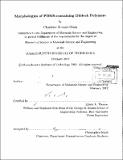| dc.contributor.advisor | Edwin L. Thomas. | en_US |
| dc.contributor.author | Stewart-Sloan, Charlotte (Charlotte Roberta) | en_US |
| dc.contributor.other | Massachusetts Institute of Technology. Dept. of Materials Science and Engineering. | en_US |
| dc.date.accessioned | 2013-01-07T21:23:31Z | |
| dc.date.available | 2013-01-07T21:23:31Z | |
| dc.date.copyright | 2012 | en_US |
| dc.date.issued | 2012 | en_US |
| dc.identifier.uri | http://hdl.handle.net/1721.1/76132 | |
| dc.description | Thesis (S.M.)--Massachusetts Institute of Technology, Dept. of Materials Science and Engineering, 2012. | en_US |
| dc.description | Cataloged from PDF version of thesis. | en_US |
| dc.description | Includes bibliographical references (p. 117-123). | en_US |
| dc.description.abstract | The morphologies of polydimethylsiloxane (PDMS)-containing diblock polymers are investigated as a function of volume fraction, segregation, processing procedure, and temperature. Strongly segregated polyisoprene-PDMS and polystyrene-PDMS diblocks are prepared according to standard procedures in the literature by anionic synthesis in the laboratory of Professor Apostolos Avgeropoulos at the University of Ioannina in Ioannina, Greece and their morphologies are investigated using small angle x-ray scattering and transmission electron microscopy. Good agreement is found between this work and other work on the structures of diblocks containing PDMS with a variety of complementary blocks and between this work and theoretical predictions for the morphologies of diblock polymers. Different processing treatments including casting from solvents with a range of preference for each block and a week-long anneal are tested to determine whether processing has a strong effect on final morphology; it is found that in most cases the morphology displayed after processing is consistent independent of the processing treatment, indicating that the morphologies are in equilibrium and fairly robust to preparation procedure. Finally, selected weakly segregated diblocks were studied at varying temperatures using synchrotron small angle x-ray scattering. The diblock samples appeared to be affected by the prior x-ray dose that the materials had received. With limited prior dose, the materials studied were ordered with little dramatic change in morphology throughout the temperatures investigated; under continual irradiation by a 1.371Å (9.1 keV) beam for half an hour, the samples were damaged. The thesis concludes with a summary and suggestions for future work, including a discussion of experimental and theoretical work on the ways that equilibrium morphologies of block copolymers are perturbed when they are spatially confined to dimensions on the order of several times their repeat period. The small domain sizes achievable with and technological relevance of PDMS-containing diblocks make them ideal for use in microelectronics and information storage which provides a motivation for exploring this topic further. | en_US |
| dc.description.statementofresponsibility | by Charlotte Stewart-Sloan. | en_US |
| dc.format.extent | 123 p. | en_US |
| dc.language.iso | eng | en_US |
| dc.publisher | Massachusetts Institute of Technology | en_US |
| dc.rights | M.I.T. theses are protected by
copyright. They may be viewed from this source for any purpose, but
reproduction or distribution in any format is prohibited without written
permission. See provided URL for inquiries about permission. | en_US |
| dc.rights.uri | http://dspace.mit.edu/handle/1721.1/7582 | en_US |
| dc.subject | Materials Science and Engineering. | en_US |
| dc.title | Morphologies of PDMS-containing diblock polymers | en_US |
| dc.title.alternative | Morphologies of morphologies of polydimethylsiloxane-containing diblock polymers | en_US |
| dc.type | Thesis | en_US |
| dc.description.degree | S.M. | en_US |
| dc.contributor.department | Massachusetts Institute of Technology. Department of Materials Science and Engineering | |
| dc.identifier.oclc | 821683507 | en_US |
